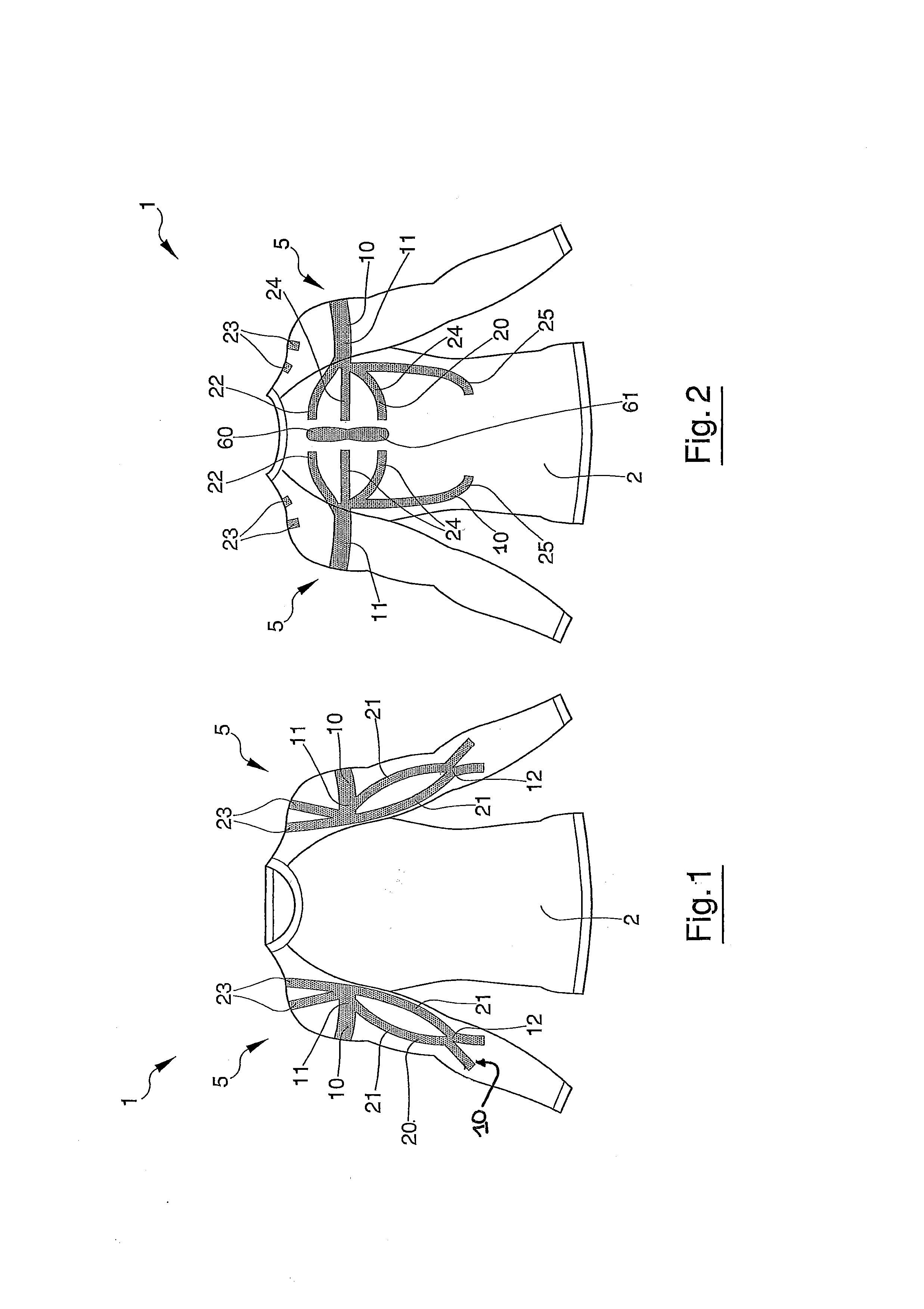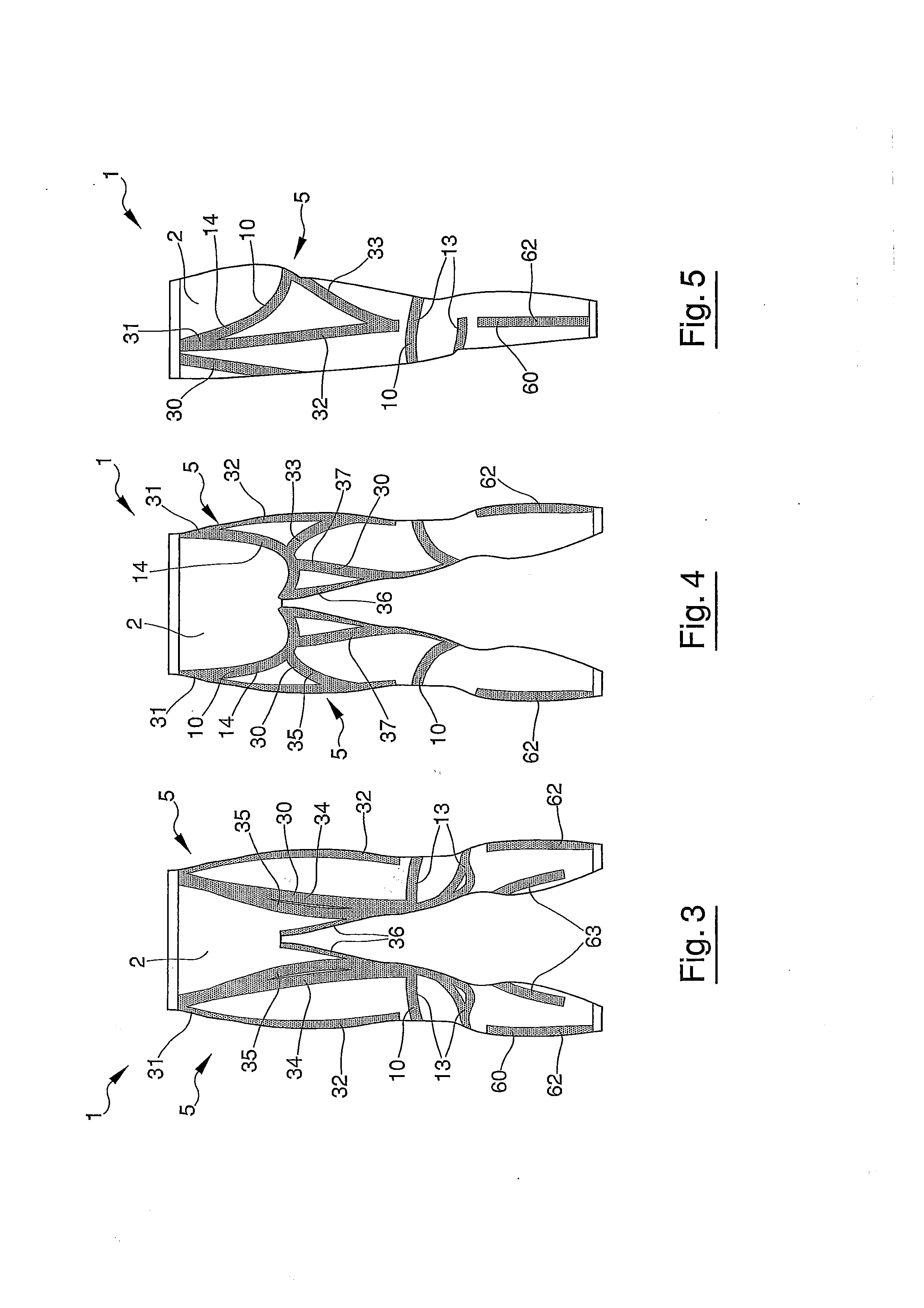Garment for the neuro-musculo-skeletal assistance
a neuromusculoskeletal and assistance technology, applied in the direction of protective garments, garments, apparel, etc., can solve the problems of not being able to achieve the desired effect in terms of injury prevention and rehabilitation, not being able to reproduce the technique of “taping” and in fact being a complex technique, etc., to achieve the effect of easy and precise resin moulding, high repeatability, and advantageous automation
- Summary
- Abstract
- Description
- Claims
- Application Information
AI Technical Summary
Benefits of technology
Problems solved by technology
Method used
Image
Examples
first embodiment
[0130]FIGS. 1 and 2 schematically show the invention. In this embodiment, the garment 1 is a sweater and the framework 5 comprises an anchoring portion of the under acromial deltoid region of the humerus 11, an anchoring portion of the front region of the elbow 12, an active portion of the biceps muscle 21, a scapular supraspinatus active portion 22, a coracoid active portion 23, a scapular infraspinatus active portion 24 and an active portion of the latissimus dorsi muscle 25.
[0131]The framework preferably comprises two separate active portions of the biceps muscle 21, preferably having a first end terminating on the anchoring portion of the under acromial deltoid region of the humerus 11 and a respective second end terminating on the anchoring portion of the front region of the elbow 12.
[0132]The framework preferably comprises two separate coracoid active portions 23, preferably having a first end terminating on the anchoring portion of the under acromial deltoid region of the hum...
second embodiment
[0136]FIGS. 3, 4 and 5 schematically show the invention. In this embodiment, the garment 1 is in the form of trousers, intended to cover the user's body from the waist to the ankles, and the framework 5 comprises a popliteal spiral anchoring portion 13, an under-buttock anchoring portion 14, an active portion of the gluteus medius muscle 31, an active portion of the tensor fasciae latae muscle 32, an active portion of the biceps muscle 33, an active portion of the sartorius muscle 34, an active portion of the vastus medialis 35, an active portion of the gracilis muscle 36 and an active portion of the semitendinosus muscle 37.
[0137]The garment in the form of trousers preferably comprises a second reinforcement strip 62 intended to coincide with the user's peroneus muscle.
[0138]The garment in the form of trousers preferably comprises a third reinforcement strip 63 intended to coincide with the user's tibial muscle.
third embodiment
[0139]FIGS. 6, 7 and 8 schematically show the invention. In this embodiment, the garment 1 is in the form of shorts, intended to cover the user's body from the waist to the knees, and the framework 5 comprises an under-buttock anchoring portion 15, an active portion of the gluteus medius muscle 41, an active portion of the tensor fasciae latae muscle 42, an active portion of the biceps muscle 43, an active portion of the sartorius muscle 44, an active portion of the vastus medialis 45, an active portion of the gracilis muscle 46 and an active portion of the semitendinosus muscle 47.
[0140]What is described above with reference to FIGS. 6, 7 and 8 can also be repeated for the solution shown in FIGS. 9 and 10.
[0141]FIG. 11 shows another solution. The framework 5 opportunely comprises a ring 9 made of resin intended to surround the user's kneecap. This makes it possible to better support the kneecap and / or to reduce the risk of damage due to inappropriate movements of the knee.
[0142]As ...
PUM
 Login to View More
Login to View More Abstract
Description
Claims
Application Information
 Login to View More
Login to View More - R&D
- Intellectual Property
- Life Sciences
- Materials
- Tech Scout
- Unparalleled Data Quality
- Higher Quality Content
- 60% Fewer Hallucinations
Browse by: Latest US Patents, China's latest patents, Technical Efficacy Thesaurus, Application Domain, Technology Topic, Popular Technical Reports.
© 2025 PatSnap. All rights reserved.Legal|Privacy policy|Modern Slavery Act Transparency Statement|Sitemap|About US| Contact US: help@patsnap.com



